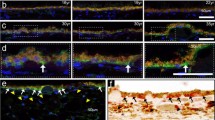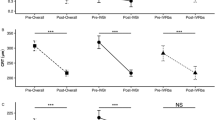Summary
To determine the toxic effect of whole blood and hemoglobin on the retina, volumes of autogenous blood varying between 0.3 and 1.5 ml and various hemoglobin concentrations were injected intravitreally into speciosa monkeys. Electroretinograms were performed at the outset of the experiment and immediately before sacrifice. After six weeks the animals were killed and the eyes were processed for histologic and electron microscopic examination.
Three intravitreal injections of 0.3 ml of autogenous blood administered at one-month intervals or one injection of 22.4 mg of hemoglobin did not produce a toxic effect on the retina demonstrable by light or electron microscopic examination or electroretinography. Intravitreal injection of more than 0.6 ml of whole blood or 40 mg of hemoglobin produced definite toxic effects histologically and electroretinographically. The damage found histologically correlated well with the degree of hemosiderin deposition. Explosive lesions produced by xenon arc photocoagulation to induce moderate vitreous hemorrhage failed to produce toxic doses of blood within the eye.
In humans undergoing vitrectomy to remove vitreous hemorrhage, the amount of whole blood recovered from vitrectomy fluid was considered nontoxic, except when the patient had massive vitreous hemorrhage or intraoperative bleeding.
Zusammenfassung
In den Glaskörper von Affen wurden verschiedene Mengen von Eigenblut (0,3–1,5 ml) und verschiedene Konzentrationen von Hämoglobin injiziert, um die toxische Wirkung von Blut und von Hämoglobin auf die Netzhaut zu bestimmen. Elektroretinogramme wurden vor dem Experiment und nach dessen Beendigung abgeleitet. Sechs Wochen nach der Injektion wurden die Tiere getötet und die Augen licht- und elektronenmikroskopisch untersucht.
Drei intravitreale Injektionen von 0,3 ml Eigenblut, gegeben in monatlichen Abständen, oder eine Injektion von 22,4 mg Hämoglobulin verursachten keinen Netzhautschaden, der mikroskopisch oder elektroretinographisch nachweisbar gewesen wäre. Intravitreale Injektionen von mehr als 0,6 ml Eigenblut oder 40 mg Hämoglobin erzeugten toxische Effekte, die mikroskopisch und elektroretinographisch nachweisbar waren. Der Schaden entsprach dem Grad der Hämosiderinablagerung. Explosiv-Schaden, verursacht durch Xenon-Lichtkoagulation, um Glaskörperblutungen hervorzurufen, hatte kein toxisches Blutvolumen innerhalb des Auges zur Folge.
Die Blutmenge, die bei einer Vitrektomie ausgewaschen wird, wenn diese wegen Glaskörperblutung zur Durchführung gelangt, hat sich als nichttoxisch erwiesen. Ausgenommen sind Patienten mit massiver Blutung oder intraoperativer Blutung in den Glaskörper.
Similar content being viewed by others
References
Babel, J.: L'action toxique de l'hemosiderine sur les tissue oculaires. Arch. Ophthal. (Paris) 24, 405–416 (1964)
Cibis, P. A., Yamashita, T.: Experimental aspects of ocular siderosis and hemosiderosis. Amer. J. Ophthal. 48, 465–480 (1959)
Duke, J. R.: Ocular effects of systemic siderosis in the human. Amer. J. Ophthal. 48, 628–633 (1958)
Francois, J., Hanssens, M.: Histopathological examination of a case of Eales' disease. Bull. Soc. belge Ophthal. 131, 358–370 (1962)
Holm, A. G., Bennett, W.: Hemosiderosis bulbi following trauma. Amer. J. Ophthal. 53 (1962)
Masciulli, L., Anderson, D. R., Charles, S.: Experimental ocular siderosis in the squirrel monkey. Amer. J. Ophthal. 74, 638–661 (1972)
Oguchi, C.: Über die Wirkung von Blutinjektionen in den Glaskörper nebst Bemerkungen über die sog. Retinitis proliferans. Albrecht v. Graefes Arch. Ophthal. 84, 446–520 (1913)
Regnault, F. R.: L'hemorragie intravitréene; thesis. Paris: Polycopie Gilanne 1966
Regnault, F. R.: Vitreous hemorrhage, an experimental study. Arch. Ophthal. 83, 458–474 (1970)
Samuels, B., Fuchs, A.: Clinical Pathology of the Eye. New York: Paul B. Hoeber, Inc. 1952
Squire, C., McEwen, W. K.: The effect of iron compounds on rabbit vitreous. Amer. J. J. Ophthal. 46, 356–358 (1958)
von Hippel, E.: Über Siderosis Bulbi und die Beziehungen zwischen Siderotischer und Hämatogener Pigmentierung. Albrecht v. Graefes Arch. Ophthal. 40, 123–279 (1894)
Author information
Authors and Affiliations
Additional information
This investigation was supported in part by Public Health Service 1107-02 and in part by the Lions of Illinois Foundation.
Rights and permissions
About this article
Cite this article
Sanders, D., Peyman, G.A., Fishman, G. et al. The toxicity of intravitreal whole blood and hemoglobin. Albrecht von Graefes Arch. Klin. Ophthalmol. 197, 255–267 (1975). https://doi.org/10.1007/BF00410870
Received:
Issue Date:
DOI: https://doi.org/10.1007/BF00410870




